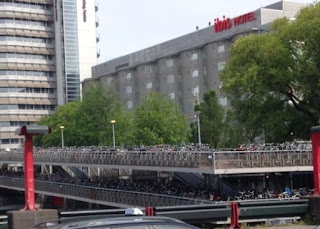 |
New bike racks at Hart Elementary School in Austin
(photo courtesy of the City of Austin) |
Back in 1969 (what my kids now
refer to as the “olden days”), walking and bicycling to school was part of
everyday life. Nearly half of all students traveled to school on foot or by
bike. Today, that’s no longer the case, with only 13% of children walking or
bicycling to school. Meanwhile, the percentage of children arriving at school
by private automobile has increased from 12% to 44% (the rate of school bus
ridership has stayed almost the same).
Austin is home to a number of
innovative programs to encourage kids to bicycle to school. Last month,
the City of Austin launched a major bicycle/walk-to-school initiative at Hart
Elementary School, which serves a high proportion of low-income students with
limited opportunities to be active. Along with the installation of a 1.3-mile cycle
track connecting nearby apartment complexes to the school, the City secured 300
bikes to donate to children who commit to cycling to school. As of this week, more than 80 kids were cycling to school regularly!
 |
The Bike Train at Hart Elementary School in Austin
(photo courtesy of the City of Austin) |
As part of the program, the City
has set up bike trains and walking school buses with adult monitors to pick the
students up from their apartment complexes and supervise their commute to
school. (A bike train is an organized
group of students who cycle together along a pre-arranged route to school under
the close supervision of adults. A
walking school bus is the pedestrian
version of a bike train.) When the students arrive on campus, they swipe a
special card so their parents can know they arrived safely.
In addition to the City’s program
at Hart Elementary, at least five other elementary schools in Austin low-income
neighborhoods have recently started walking school bus programs. Meanwhile,
parents and PTA organizations at a number of local schools have started their
own bike trains. The City of Austin’s Child Safety program provides support to
parents who want to set up their own bike trains, by providing maps for
customized biking routes and reflective arm bands for participants.
 |
Boltage program at Doss Elementary School
(photo courtesy of AISD) |
Several area schools, including
Doss Elementary and Martin Middle Schools, have adopted high-tech approaches to
get kids on bikes. One of these programs, Boltage, uses a solar-powered reader
that records each child’s bike trip to school. The records are then used to
reward students who commute to school regularly by bike.
While Austin has made great progress
recently in encouraging kids to cycle and bike to school, our community has a long
ways to go if we want to reclaim the days when one out of every two kids
bicycled or walked to school. By helping kids walk and bicycle to
school, we can make a dent in child obesity rates here in Austin, where
38% of children in grades 3 to 8 are overweight or obese. Increasing
cycling and walk-to-school rates also reduces traffic congestion. In some
communities, as much as 30% of vehicle traffic in the morning rush hour is from
children being driven to school.
Safety remains the biggest barrier to getting more kids on bikes.
We should all be advocating at City Hall for more local funding to create safer
routes to schools, including sidewalks, cycle tracks, and neighborhood traffic
calming. I love seeing what other cities are doing in this regards. Portland
and Seattle, for example, are both building a network of neighborhood greenways
that give priority to cyclists and pedestrians. By 2015, 80% of Portland
residents will live within half a mile of a neighborhood greenway.
At a neighborhood and school level,
setting up a bike train or walking school bus can go a long way in overcoming
parents’ concerns about safety. In Portland, bike trains are now a predominant
feature of kids’ commute to school, supported by a robust cycling culture and
even a website with information on bike trains in operation around the city. In
Seattle, the school district is working to set up a bike train or walking
school bus at every elementary school in the district.
Austin is lucky to already have
lots of success stories to build from to help our children bike and walk to
school. Working together as a community to address the remaining barriers, I
see no reason why we cannot reach the same goal that Seattle recently
adopted—to get 50% of children walking and biking to school again.
(Look for a longer version of this blog post in the November issue of Austin Fit).
















